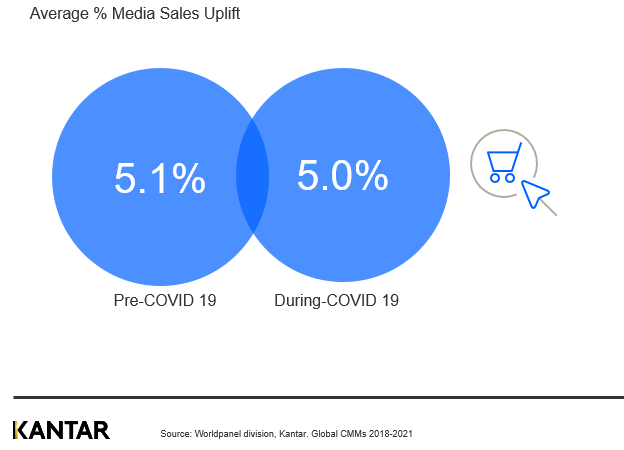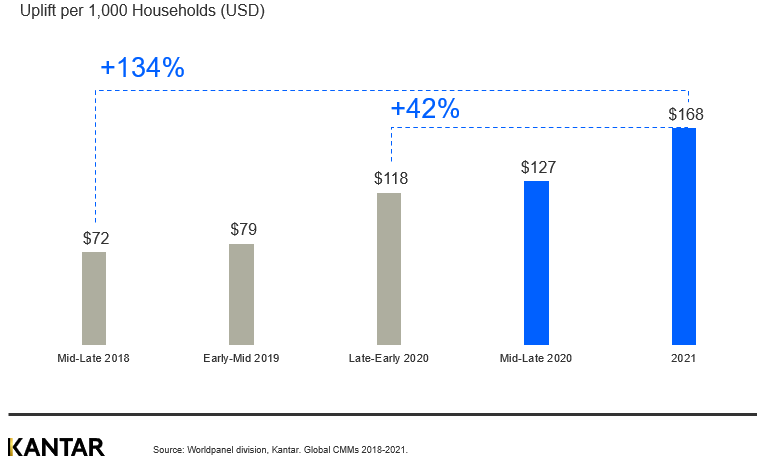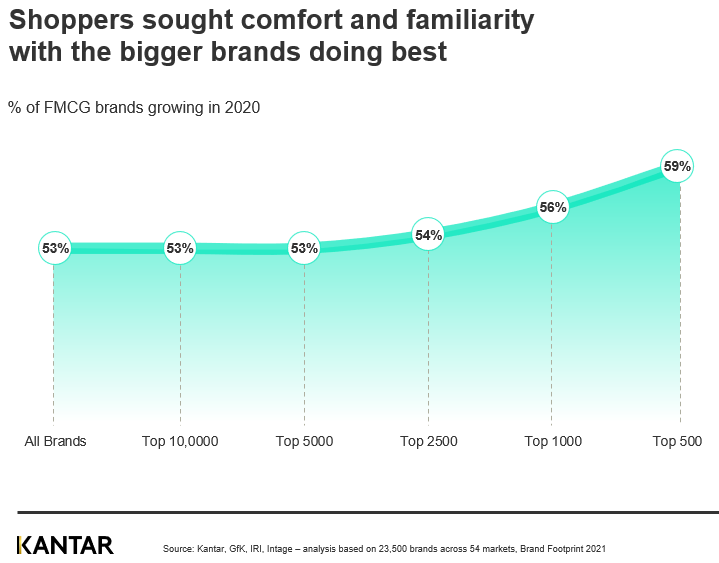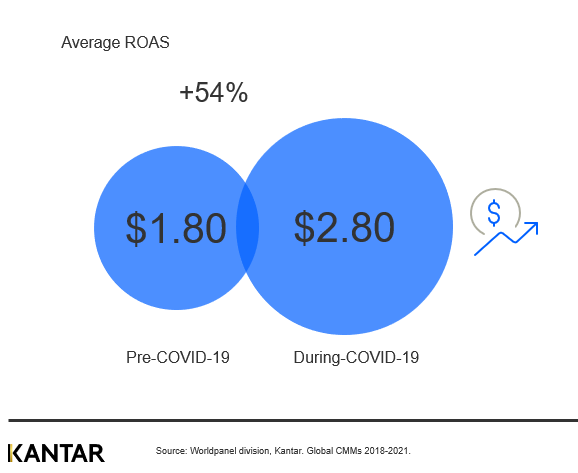It seems that wherever we look, there’s an element of our lives that’s been changed by the pandemic – from the way we work and travel, to how we communicate and shop. Then again, some things haven’t changed. While purchasing habits continuing to be affected globally, there is good news for advertisers in the FMCG sector.
So what’s become more or less effective, and what’s stayed the same? And the golden question: should FMCG brands change their advertising strategy in times of uncertainty?
Advertising still very much earns its keep
Kantar’s research shows something that hasn’t changed is the short-term sales uplift generated by advertising. There’s been significant growth in grocery spend over the last year, and advertising is responsible for driving a similar proportion of those sales as it did before the pandemic. This fact might come as a surprise given the significant evolution in shopping and media consumption habits we’ve all experienced.
COVID-19 restrictions understandably affected the number of shopping trips, led to stocking issues, and drove more people to buy online. Following the relaxation of restrictions, there’s been an increase in the frequency of shopping trips compared with before the pandemic. At the same time, we’ve seen significant sales growth for some FMCG categories and a significant decline for others.
When it comes to media consumption, while there’s been less opportunity to expose consumers to out-of-home adverts, viewing of in-home advertising increased. Influenced by the pandemic, messaging has tended to focus on brand reliability and other emotional levers.
Despite all these factors in play, the average sales uplift achieved through advertising has hardly changed since before the pandemic – dropping from 5.1% to 5% – and seems to be unaffected by such significant changes in the world around us.

The good news is that, if your brand operates in a growing category, you’ll make more money from your advertising as it grows. Effectively, your share of the pie will remain the same – it’s just a much bigger pie.
The highest buying response in history
By tracking each individual’s exposure to advertising along with their buying response, we can see how consumers have reacted to the messages they’ve seen. It narrows the ‘universe’ to look at the response of only those people who saw the advert. We call this measure the ‘uplift per thousand households’ – and 2021 saw the highest uplift ever.
This shows us that people who see adverts now are more likely to respond with a purchase – meaning that anyone spending money on advertising is getting a better return on their investment than in any previous year.

Why has advertising become more effective?
It’s probably due to a combination of factors, including better audience targeting, with the shift away from TV towards digital advertising allowing for more nuanced profiling. Then there’s the psychological element of the pandemic. People visited stores less frequently, and when they did, the aim was to finish shopping as quickly as possible to minimise chances of infection. This increased focus on speed led to more instinctive choices, with consumers more likely to lean on the ‘security’ of famous brands, based on the equity they’ve built up in the longer-term as a result of advertising.

The bottom line: investments work harder
It’s an unequivocal fact that advertising has become more persuasive to those it reaches, something that is clear from the significant improvement in return on advertising spend (ROAS) gains.

Those who invested in media during pandemic restrictions saw a 54% increase in their ROAS compared with the time before COVID-19 hit. Using another industry measure: for every $1 spent on advertising, brands saw a return of $2.80 during the pandemic compared with pre-pandemic levels of $1.80.
The rise in ROAS was also helped by the fact that some media channels reduced advertising costs due to a fall in demand. This led to a fantastic opportunity to cut through the noise during the pandemic, and some brands wisely took full advantage of this.
To answer the golden question...
Do times of uncertainty mean we should change our advertising strategy? The answer is essentially no: media-driven sales remain constant, and continue to be responsible for incremental sales, while any move to stop advertising will negatively affect short-term sales.
Advertising has become more effective. In the current climate, higher returns are available if you can reach the people who will be most receptive to your brand and message, and those most likely to purchase – such as your lapsed brand buyers who remain heavy category buyers. Reaching these people will help you maximise your advertising dollar.
While uplifts will remain a constant in 2022, you can boost your ROAS by focusing on effectiveness.
Based on the findings of this research we have three clear recommendations:
- Don’t stop advertising.
- Drive effectiveness by targeting those with a known propensity to purchase.
- Can you find a 5% short-term sales uplift elsewhere? Re-invest efficiency savings for future campaigns to achieve greater gains.
To find out more, please reach out to our experts and watch the webinar on this topic.

